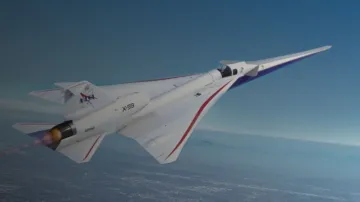NASA has partnered with Lockheed Martin Skunk Works which reveals its groundbreaking quiet supersonic aircraft named the X-59. The jet aligns with its commitment to advance commercial supersonic travel and the experimental aircraft has been poised to redefine air travel with a predicted top speed of 1.4 times the speed of sound or 1,488 kilometres per hour.
Key Features
Design for quiet supersonic flight: The X-59's distinctive features include a thin, tapered nose, comprising approximately one-third of its total length. The design has been strategically aimed at deflecting shock waves that typically result in sonic booms from traditional supersonic planes.
Dimension and cockpit configuration: The aircraft spans 99.7 feet in length and 29.5 feet in width. Engineers opted for a cockpit placement nearly halfway down the aircraft's length, eliminating forward-facing windows to enhance supersonic performance.
Sonic boom mitigation: To minimize the disruptive effects of sonic booms, the X-59 has been engineered with an engine mounted on top and a smooth underside to prevent shockwaves from converging behind the aircraft.
NASA's Quesst Mission: Details
- The X-59 is the main focus point of NASA's Quesst mission, which aims to provide crucial data for regulators to rethink the regulations which are prohibiting commercial supersonic flights over land.
- Sonic Boom Reevaluation: The United States and other countries have enforced a ban on such flights for the past 50 years due to the disruptive impact of loud sonic booms on neighbouring communities.
NASA's X-59
Future flight testing
Public Feedback
Following the completion of flight testing, NASA has been planning to fly the X-59 over the selected U.S. cities to gather public feedback on the sound it produces. The data collected will be shared with regulatory authorities, including the international counterparts and the Federal Aviation Administration.
Supersonic Flight Evaluation
Bob Pearce, Associate Administrator for Aeronautics Research Mission at NASA has emphasized that the laboratory studies suggest that the X-59's soft thump is conducive to supersonic flight over land, real-world validation requires engagement with those who would experience it in daily life.
NASA's X-59 jet represents a significant leap forward with supersonic travel technology, with its innovative design aimed at minimizing noise disruptions. The collaborative efforts between NASA and Lockheed Martin Skunk Works under a transformative milestone work towards redefining the future of commercial air travel.
ALSO READ: Elon Musk expresses discomfort, seeks increased voting control at Tesla to advance AI initiatives

